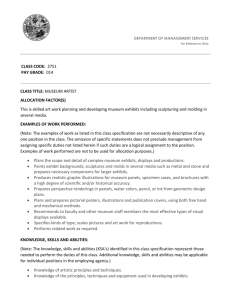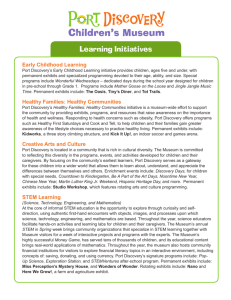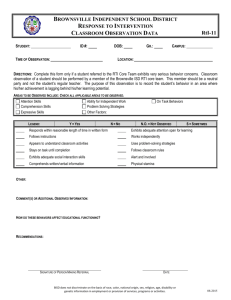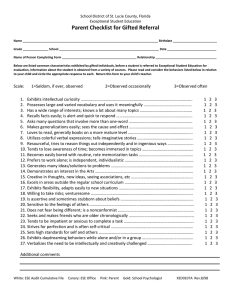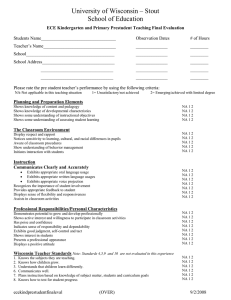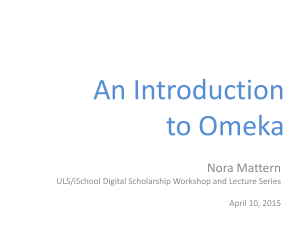Omeka in the classroom: The challenges of teaching material
advertisement
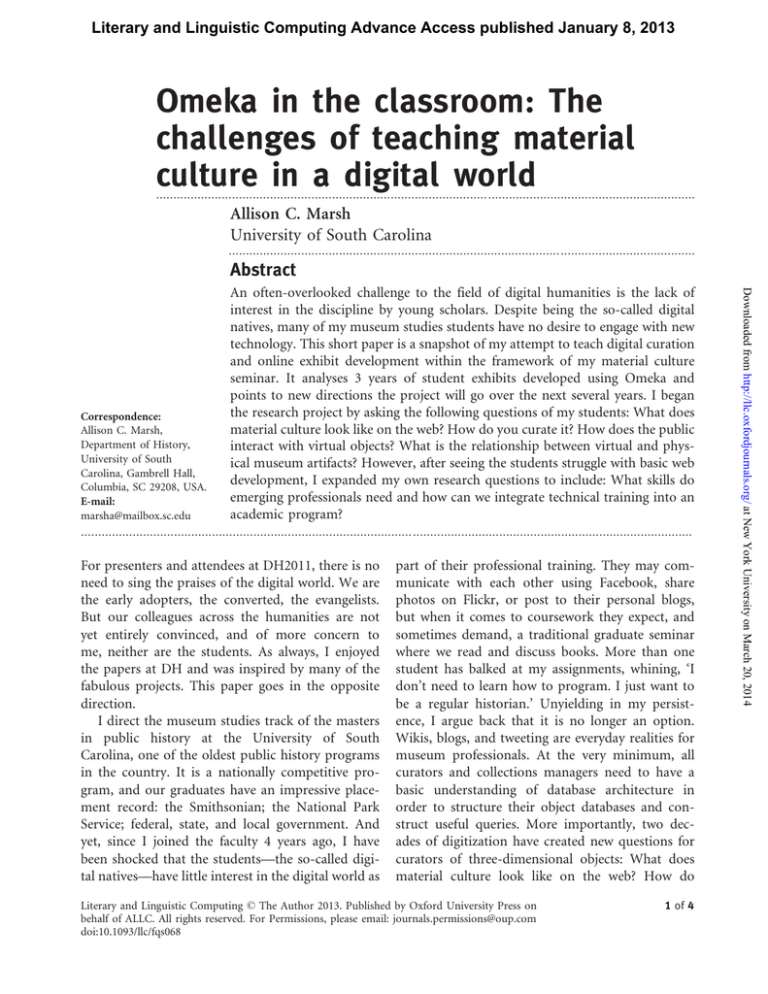
Literary and Linguistic Computing Advance Access published January 8, 2013 Omeka in the classroom: The challenges of teaching material culture in a digital world ............................................................................................................................................................ Allison C. Marsh University of South Carolina ....................................................................................................................................... Abstract ................................................................................................................................................................................. For presenters and attendees at DH2011, there is no need to sing the praises of the digital world. We are the early adopters, the converted, the evangelists. But our colleagues across the humanities are not yet entirely convinced, and of more concern to me, neither are the students. As always, I enjoyed the papers at DH and was inspired by many of the fabulous projects. This paper goes in the opposite direction. I direct the museum studies track of the masters in public history at the University of South Carolina, one of the oldest public history programs in the country. It is a nationally competitive program, and our graduates have an impressive placement record: the Smithsonian; the National Park Service; federal, state, and local government. And yet, since I joined the faculty 4 years ago, I have been shocked that the students—the so-called digital natives—have little interest in the digital world as part of their professional training. They may communicate with each other using Facebook, share photos on Flickr, or post to their personal blogs, but when it comes to coursework they expect, and sometimes demand, a traditional graduate seminar where we read and discuss books. More than one student has balked at my assignments, whining, ‘I don’t need to learn how to program. I just want to be a regular historian.’ Unyielding in my persistence, I argue back that it is no longer an option. Wikis, blogs, and tweeting are everyday realities for museum professionals. At the very minimum, all curators and collections managers need to have a basic understanding of database architecture in order to structure their object databases and construct useful queries. More importantly, two decades of digitization have created new questions for curators of three-dimensional objects: What does material culture look like on the web? How do Literary and Linguistic Computing ß The Author 2013. Published by Oxford University Press on behalf of ALLC. All rights reserved. For Permissions, please email: journals.permissions@oup.com doi:10.1093/llc/fqs068 1 of 4 Downloaded from http://llc.oxfordjournals.org/ at New York University on March 20, 2014 Correspondence: Allison C. Marsh, Department of History, University of South Carolina, Gambrell Hall, Columbia, SC 29208, USA. E-mail: marsha@mailbox.sc.edu An often-overlooked challenge to the field of digital humanities is the lack of interest in the discipline by young scholars. Despite being the so-called digital natives, many of my museum studies students have no desire to engage with new technology. This short paper is a snapshot of my attempt to teach digital curation and online exhibit development within the framework of my material culture seminar. It analyses 3 years of student exhibits developed using Omeka and points to new directions the project will go over the next several years. I began the research project by asking the following questions of my students: What does material culture look like on the web? How do you curate it? How does the public interact with virtual objects? What is the relationship between virtual and physical museum artifacts? However, after seeing the students struggle with basic web development, I expanded my own research questions to include: What skills do emerging professionals need and how can we integrate technical training into an academic program? A. C. Marsh 2 of 4 Literary and Linguistic Computing, 2013 have made in order to encourage budding historians to get their toes wet in the digital arena. For their final assignment, students must create records for each of their objects, which include uploading images, entering Dublin Core metadata, tagging objects with keywords, and writing short descriptions. The students then must curate their own exhibit, either by using one of the theme templates provided by CHNM or by creating their own. The open-source software allows students who are more skilled or interested in web design to create more elaborate exhibits. So far the results of the online exhibits have been mostly disastrous. As a whole, the exhibits are terrible (available at http://hist787.cas.sc.edu). They have clunky navigation, lack any elegance in design and often are just plain boring. One example from an English MA student shows her reluctance to incorporate images into her text: http://hist787.cas. sc.edu/exhibits/show/methods-of-memory. If you click on a link to one of the objects (http:// hist787.cas.sc.edu/exhibits/show/methods-of-memo ry/medieval-rememberings), you can see why. She was unable to figure out how to crop and centre her image. In fact, simply getting students to upload photos that are in focus seems to be problematic: (http://hist787.cas.sc.edu/exhibits/show/old-stuff/ what-kind/heirlooms). A few of the students did manage to accomplish a storyline, for example http://hist787.cas.sc.edu/exhibits/show/bringingpaper-to-life/1, although still not a particular compelling online exhibit. Clicking on only a few of the exhibits, the dual challenges of the assignment become clear: (1) students need more training on basic digital tools and (2) students need more training on effective narration/curation/storytelling in an online exhibit. Too often students were trying to translate something that would work well as a paper into something that was disastrous online. In many ways, the exhibits are proof of my distrust of black box software for developing online exhibits and are an indicator that anyone who wants to engage seriously in the virtual world needs significantly more training (either formally or informally) than a few hours of online tutorials can provide. More generously, these online exhibits are often the first experience students have in Downloaded from http://llc.oxfordjournals.org/ at New York University on March 20, 2014 you curate it? How does the public interact with virtual objects? What is the relationship between virtual and physical museum artefacts? I want my students to struggle with these questions, and this paper is a short excursion into the trial-by-fire approach of my material culture seminar. Each fall I teach HIST 787: Material Culture Studies, the foundational graduate seminar for the museums track in our masters program. On the first day of class, I ask the students to bring in five objects that describe either themselves or their research interests. I tell them to choose wisely, as they will be using those objects every week for the entire semester, but otherwise I give no guidance to object selection. The objects serve multiple purposes throughout the semester, but most importantly they are part of a larger project to create a virtual object database that represents the changing attitudes towards material culture in the digital age. As a final project, each year the students must create an online exhibit drawing from the objects in the database; they can select from the objects of both their classmates as well as the students of previous years. Clearly, each year the number of objects in the database increases, and the distance from the early contributors becomes greater. I am in Year 3 of what I anticipate to be a decade long study, and this short paper is designed to give preliminary results. Because this course is part of a 2-year master’s degree, this is the first year where the students do not have direct access to the owners of objects from previous classes. I have chosen Omeka as the platform for this assignment. Although I am well aware of the limitations, as well as the potential, of the open-source software, Omeka has a low barrier for entry. Omeka was developed by George Mason University’s Roy Rosenzwig Center for History and New Media (CHNM) with non-IT specialists in mind. CHNM’s goal was (and continues to be) to provide museum and library professionals with a tool that allows them to concentrate on content and interpretation without worrying about programming.1 Personally, I am concerned that by using a black box application, my students do not fully understand the implications of engaging with the virtual world. However, that is one of the compromises I Omeka in the classroom there was also some recognition of particularly digital difficulties. One student brought in the program for the up-coming NCPH annual conference (the main professional organization in my field) and said, ‘Dr. Marsh, Did you know that George Mason was hosting a half day workshop on Omeka?’ Sighing, I replied that my coursework was in fact designed to be useful, even if they did not see it that way. For the more curious students—dare I say the better students—slogging through my assignment made them want to improve Omeka. They recognized the need and potential for an open-source database that accepted three-dimensional objects, audio, and video. They wanted to challenge the text-based digital humanists to consider the difficulties of encoding images and sound. They saw the opportunity for a tool to create online exhibitions with ease, useful for the small museums and historical associations that lack IT departments. I now have a group of students and recent alumni who, after assessing the various free applications available, decided Omeka was the best of the lot and are currently using it in a collaborative project with the Smithsonian National Museum of American History (www.olympiamills.cas.sc.edu). The group is engaged in ‘active reflection’ on the exhibition development process (http://developingele.wordpress.com/). They are keeping track of the difficulties that they, as novices, encounter. They are writing concise how-to guides that they call learning modules for each step of the project. They are working to educate their peers on how to take small steps into the digital world. So did it work? The answer is a resounding ‘kind of.’ My presentation at DH2011 was not an awe-inspiring game changer, but it elicited laughs, nods of agreement, and empathy from all of the professors and museum professionals in the audience. Discussion overflowed into the hallways as numerous people came up to me with similar stories. Considering the enthusiasm with which my paper was received, I am somewhat (although not all together) surprised that there were few similarly styled papers at the conference, and even fewer in print publication, that outlined the pedagogical problems associated with digital humanities. As a Literary and Linguistic Computing, 2013 3 of 4 Downloaded from http://llc.oxfordjournals.org/ at New York University on March 20, 2014 curating, and so one of the assignment’s goals is for students to gain skills in developing effective narrative techniques (useful in both physical and digital curation). In assessing their work, it is important to be mindful of the learning process; remember that they are professionals in training, and they should not be judged on their first attempt but rather on the progress they achieve by the time they graduate. However, as a pedagogical device, the assignment has been tremendously successful. By working through the process of creating an online exhibit, the students naturally confront the many epistemic questions relating to the use of physical objects in a virtual environment. Students immediately recognize the diverse challenges of working in the digital format, from the pedestrian, such as how to search for items when a previous user failed to enter appropriate metadata, to the substantial, such as questioning the ethics of using an object as a metonym in an exhibit that is antithetical to the physical object’s authenticity. My goal for the assignment is not for students to become master web designers, but for them to engage in the questions confronting digital curation. Although I could go on at length about the implications of this ongoing assignment, I want to offer questions, rather than conclusions, on the joint challenges of curating digital resources and the role of digital humanities in the academic curricula—how are universities training the next generation of museum professionals who will have to confront digital curation? What are effective teaching techniques? What skills do museum professionals believe graduating students should have? How do professors balance the need to provide theoretical training in how to read and interpret material culture while fostering the development of technical skills in an ever-changing digital landscape? At breakfast on the very first day of DH2011, I happened to sit down with two developers for Omeka. After hearing about my project, they asked: ‘But did it work?’ The answer, of course, is all in what you choose to assess. The object database is a mess. Metadata is just about non-existent. The exhibits are lousy. Everyone involved (both the students and myself) are frustrated. But at the end of the course, although there was still a lot of whining, A. C. Marsh 4 of 4 Literary and Linguistic Computing, 2013 graphic design students can bring their aesthetic eye and talent to help our sad web pages; I hope my own history students will be able to work on developing strong content, while learning how to navigate the digital world. This short paper is a snapshot—Year 3 of an anticipated 10-year project. It shows how the questions asked over time change as the project takes shape. In a few more years, I plan on writing the long paper, perhaps even two long papers: one on material culture in a virtual world and one on the curricular needs and job skills for emerging professionals in the twenty-first century. References Terras, M. (2011). Present, not voting: Digital Humanities in the Panopticon: closing plenary speech, Digital Humanities 2010. Literary and Linguistic Computing, 26(3): 257–69. Were, G. (2008). Out of Touch? Digital Technologies, Ethnographic Objects and Sensory Orders. In Chatterjee, H. (ed.), Touch in Museums. Oxford: Berg, pp. 121–33. Notes 1. http://omeka.org/about/. The Omeka showcase has rich examples of the power of the tool to create beautiful websites that combine online exhibits, archives, and collections management. My students found the showcase to be a double-edged sword. On the one hand, they were inspired by the possibilities, but on the other hand, it highlighted their frustrations with their own lack of web development skills. In many ways, they found the showcase to be misleading because of the difficulty of first time users to create similar sites. 2. My assignment is in no way a unique experiment. Professors across the humanities are having students create online exhibits using a wide variety of formats and software. The learning objectives are diverse, depending on the course and the discipline. For example, Shannon Mattern at The New School has students in her Media þ Materiality course develop online exhibits using Wordpress: http://www.wordsinspace.net/mediamateriality/2012-spring/. Graeme Were has anthropology students examine digital objects in a virtual learning environment and create exhibits within the Moodle platform. Downloaded from http://llc.oxfordjournals.org/ at New York University on March 20, 2014 field, I believe we should be more cognizant of what is not working and openly discuss what to do about it (Were, 2008).2 In her closing plenary for DH 2010, Melissa Terras correctly acknowledged the importance of digital presence and identity for the discipline of DH itself. In the case study she used, Transcribe Bentham, she remarked on her luck to have a PhD student, Rudolf Ammann, who is also a gifted graphic designer. She then goes on to outline the challenges of DH jobs, whether they should require a PhD, and problems of unemployment or underemployment for young scholars (Terras, 2011). What was missing was the need of graphic design as a component in the curriculum of current young scholars. The establishment of new MA programs in Digital Humanities will help strengthen the discipline of DH, but I am interested in how we reach young scholars who just want to be ‘regular’ humanists. How do we convince the digital natives who have no interest in digital scholarship that metadata, graphic design, and database architecture are becoming requirements for all scholars? My research project, which started out as an inquiry into changing attitudes about material culture, has become a longitudinal study into the technical skills of students who cycle through USC’s MA in Public History. I have not changed the assignment in my material culture seminar, but I have added in a more robust assessment framework than the usual course evaluation. Before the first day of class, I administer a front-end evaluation of students’ technical skills and their perception of what skills are necessary to become a successful museum professional. At the end of the course, after their battle with Omeka, I repeat the survey. I follow up with the students during their job search, to document what skills are in demand, and then again a year later to find out what skills they are using on the job. Additionally, I have made overtures to both the Graphic Arts department and the Library School to see if we can develop some interdisciplinary, inter-college collaborative projects where students from several fields struggle with the difficulties of multiple disciplines. I hope the library school students can help rationalize our metadata fields as part of their digital archives course; I hope the

